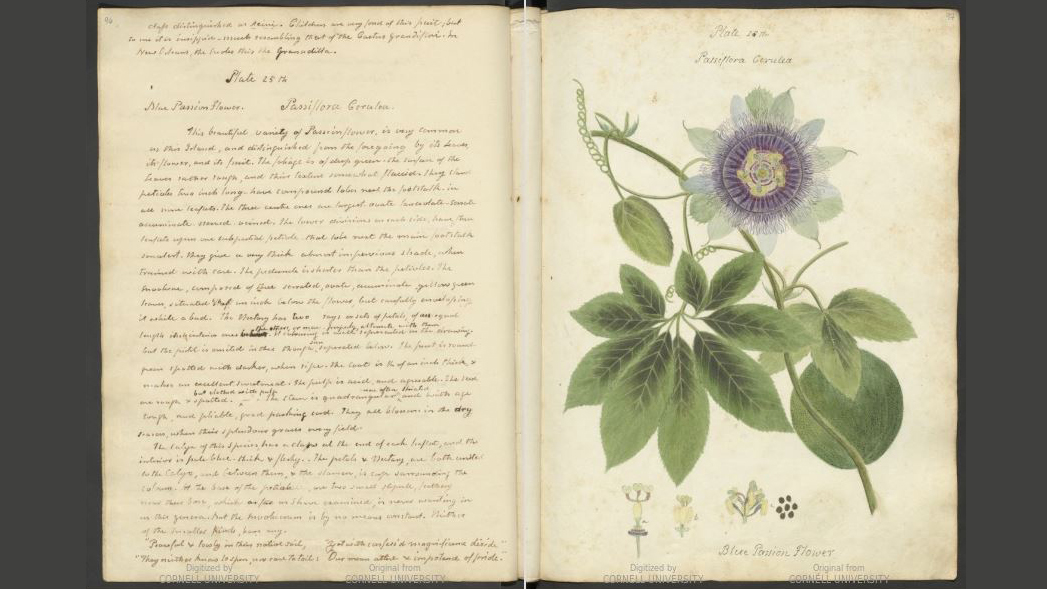Cuban Botany Manuscript Found After Being Lost for 190 Years
All three volumes of Specimens of the Plants & Fruits of the Island of Cuba by Mrs. A.K. Wollstonecraft were recently found after being deemed lost for 190 years. The manuscript contains 121 illustrated plates depicting plants native to Cuba and 220 pages of English descriptions that detail historical facts, indigenous applications, and Anne Wollstonecraft’s personal observations about the plant.
The 190-year-old illustrations, like all scientific illustrations, show dissections of plant reproductive organs as well as life cycles. This is particularly impressive because the author wrote that she did not turn to botanists for any help with her work.
Experts reflecting on the importance of Wollstonecraft’s work seem to agree that although the plants she illustrates and describes are rather common, the thorough notes on their indigenous applications are vital new information for researchers developing new medicines. For instance, in her notes, she outlines the use of soursop trees leaves as an antiparasitic and antiepileptic.
Historian and Cuban collector Emilio Cueto was crucial in finding Wollstonecraft’s work and ensuring that it is made public. 1828 marked the first mention, by two Cuban exiles, of an American woman in Cuba drawing plants for a periodical. In 1912, Cuban scholar Carlos M. Trelles cited the work, without having seen it, as a potentially seminal work in the field of botany. Following the lead of these two mentions, Cueto started his mission to find the missing manuscript.
In 2002, Cueto curated a HistoryMiami Museum exhibit on Cuban vegetation and animal species and cited Wollstonecraft’s work in the catalog bibliography without having seen it or knowing if it still existed. Scholarly networks work in this way when trying to find a work of any kind. One scholar cites it unseen essentially saying “I never saw this thing but I heard of its existence and think that it is important,” after which an oral history is utilized and historians and enthusiasts alike help each other until eventually the work is found.
Every account of the manuscript in online libraries and databases had a different spelling of the author’s name but in March 2018 Cueto was sure he had found it registered under “Wollstonecroft.” Unfortunately, the catalog did not provide a location for the manuscript so Cueto called Judith Russell, Library Dean at the University of Florida, for help. Russell was able to trace the work to Cornell University where it was received as a gift in 1923 from a faculty member who was a descendant of Wollstonecraft.
After analyzing genealogy information Judith Russell reported that Wollstonecraft died in 1828 at 46 years old, leaving her work unfinished. Emilio Cueto is working on publishing Wollstonecraft’s work and bringing the work the recognition it deserves. One of his dreams is to have the newly found manuscript displayed at the National Museum of Women in the Arts in Washington D.C. Cueto also dreams of publishing the manuscript as a book for the masses with a foreword describing the story of how the work was lost and found. He wants to also publish a Spanish translation to make the work describing Cuban Botanical and indigenous history accessible to the Cuban native audiences.
As of right now the work has been digitized and is accessible to all online:
More Info
- ‘Lost’ book of exquisite scientific drawings rediscovered after 190 years – National Geographic
- Unpublished Cuban Botanical Illustrations of Nancy Kingsbury Wollstonecraft To Be Revealed At UF – University of Florida
Please Support us on Patreon!
 The minimum level of contribution is only $1 per month.
The minimum level of contribution is only $1 per month.
Moreover, starting with the pledge level of $3, you will get a digitized vintage book about bookbinding, book history, or book arts each month from us!
These pledges help iBookBinding to continue its work and bring more information about bookbinding and book arts to you!


